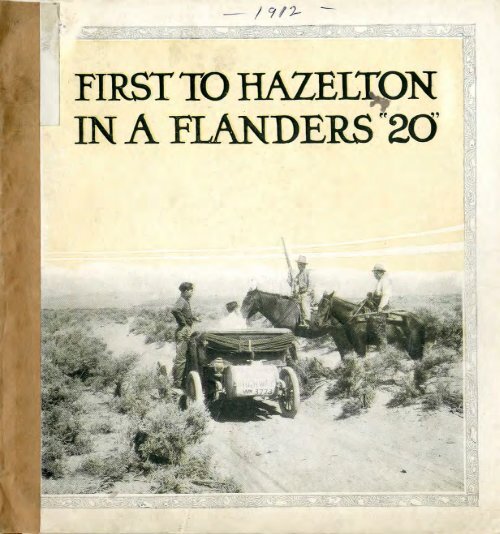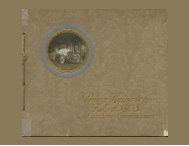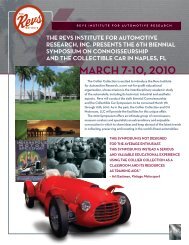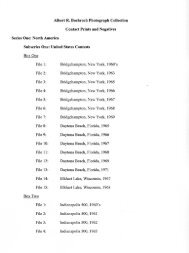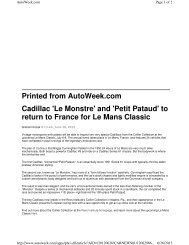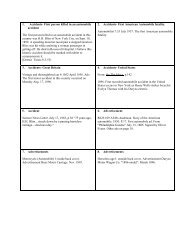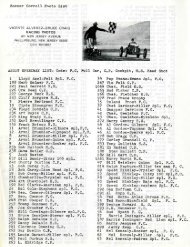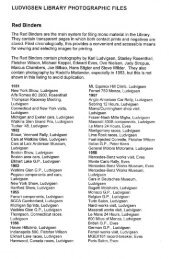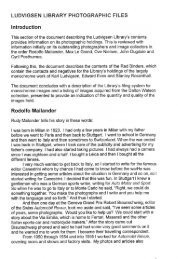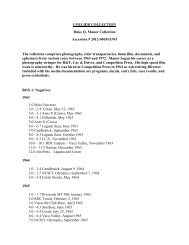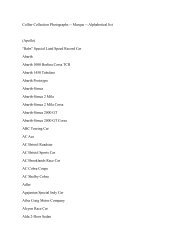"First to Hazelton" Flanders "20 - The Revs Institute
"First to Hazelton" Flanders "20 - The Revs Institute
"First to Hazelton" Flanders "20 - The Revs Institute
You also want an ePaper? Increase the reach of your titles
YUMPU automatically turns print PDFs into web optimized ePapers that Google loves.
FIRST TO HAZELTpN<br />
IN A FLANDERS 2O
lA S<strong>to</strong>ry of a<br />
PATHFINDING EXPEDITION<br />
made Us ozdii 'Path.<br />
(Sompiled by<br />
Hale "Bruske<br />
from the loq of the trip by<br />
. § . Sands<br />
7).^. Curtis<br />
STUDEBAKER CORPORATION<br />
Fac<strong>to</strong>ries<br />
Expedition Under the Auspices of<br />
the Pacific Highway Association
'<br />
FIRST TO HAZELTON<br />
In a <strong>Flanders</strong> "<strong>20</strong>"<br />
<strong>The</strong> <strong>Flanders</strong>"<strong>20</strong>'' "<strong>First</strong> <strong>to</strong> Hazel <strong>to</strong>n" car, equipped ready for the start, at Seattle, Wash.<br />
TV the big prosperous cities of the Pacific Coast, there recently sprung<br />
in<strong>to</strong> being an enthusiastic band of mo<strong>to</strong>rists known as the Pacific<br />
Highway Association. <strong>The</strong> improvement of the existing trunk lines<br />
of through travel by mo<strong>to</strong>r car is one of the chief objects of the<br />
Association. More particularly, however, is its membership bent on<br />
securing one magnificent highway through the coast states, and extending north <strong>to</strong><br />
the limits of civilization in British Columbia, and south <strong>to</strong> the Panama Canal.<br />
Mo<strong>to</strong>rists and good roads enthusiasts of all sorts are enlisted under the banner<br />
of the Association. Among the affiliating bodies is the Vic<strong>to</strong>ria Au<strong>to</strong>mobile Club,<br />
which had been for two years cus<strong>to</strong>dian of the Challoner & Mitchell trophy—
"FLANDERS <strong>First</strong> <strong>to</strong> Hazel<strong>to</strong>n In a JTianaers '<strong>20</strong>' FLMDERS<br />
In the wilderness of Snoqualmie Pass, which the "<strong>First</strong> <strong>to</strong> Hazel<strong>to</strong>n" <strong>Flanders</strong> "<strong>20</strong>"<br />
was the only car <strong>to</strong> cross in 1911<br />
a handsome medal of solid gold, donated as an award <strong>to</strong> the man who should first<br />
drive a mo<strong>to</strong>r car in<strong>to</strong> Hazel<strong>to</strong>n, B. C<br />
As Hazel<strong>to</strong>n, by its geographical position, had been agreed upon as the<br />
northern terminal of the proposed Pacific Highway, the project of exploration<br />
fitted in well with the plans of the Association.<br />
It is with the gallant and successful attempt of P. E, Sands, of Seattle, <strong>to</strong> secure<br />
this medal with his <strong>Flanders</strong> "<strong>20</strong>" that the accompanying narrative concerns itself.<br />
Partly from the many newspaper accounts, partly from personal recollections<br />
by Mr. Sands, but chiefly from Mr. Sands' log of the trip, this s<strong>to</strong>ry has been<br />
compiled. <strong>The</strong> remarkable pho<strong>to</strong>graphs with which it is illustrated are by Will<br />
T. Curtis, of Seattle, a member of the expedition.<br />
A settler's cabin in Snoqualmie Pass, where the crew of the"<strong>First</strong> <strong>to</strong> Hazel<strong>to</strong>n"<br />
<strong>Flanders</strong>"<strong>20</strong>" paused for lunch<br />
NIMATED by the same spirit which, many years before, had urged<br />
out upon a similar journey the expedition of Lewis and Clark,<br />
three men and a mo<strong>to</strong>r car left Seattle, Wash., on a journey destined<br />
<strong>to</strong> make his<strong>to</strong>ry.<br />
Like Lewis and Clark, the men were explorers, for their designed<br />
route <strong>to</strong>ok them far from the haunts of civilized man in<strong>to</strong> the great<br />
unknown. But of horses and pack animals they had none; the busy mo<strong>to</strong>r of the<br />
<strong>Flanders</strong> <strong>20</strong>" furnished the power of their chosen vehicle. Nor was there a<br />
covered wagon in their outfit.<br />
<strong>The</strong>ir destination was <strong>to</strong> be Hazel<strong>to</strong>n, British Columbia, more than 1,<strong>20</strong>0<br />
miles away. Between them and their goal stretched many a mile over which no<br />
mo<strong>to</strong>r car had ever traveled—-many a mile where not even a wheeled vehicle had<br />
ever preceded. Owner and driver of the car, executive and moving spirit of the<br />
party was P. E. Sands, mo<strong>to</strong>rist and sportsman of Seattle, normally a cool, clear-
In a r 1 a n a e r s "<strong>20</strong><br />
HANDERS<br />
<strong>The</strong>"road"through Snoqualmie Pass v/as often only the bed of a stream, along which the"<strong>First</strong> <strong>to</strong> Hazel<strong>to</strong>n"<br />
<strong>Flanders</strong>"<strong>20</strong>' had <strong>to</strong> pick its way<br />
headed business man, but on this one occasion a Paladin on adventure bent.<br />
For two years Mr. Sands had regarded the Challoner & Mitchell trophy, hung<br />
up <strong>to</strong> reward the owner of the first mo<strong>to</strong>r car <strong>to</strong> enter Hazel<strong>to</strong>n, as a personal challenge.<br />
All that time he had curbed his natural impulse <strong>to</strong> make the attempt,<br />
hoping against hope that some other mo<strong>to</strong>rist would accept the challenge and<br />
perform the feat. During that time many had announced their intention of en-<br />
. tering the lists, but always something interfered with their plans. <strong>The</strong> trophy<br />
remained <strong>to</strong> taunt Mr. Sands. In August, 1911, Mr. Sands gave way under the<br />
strain. He equipped his <strong>Flanders</strong> "<strong>20</strong>" car for the trip, invited D. F. Batchellor<br />
and W. T. Curtis <strong>to</strong> go with him, turned a deaf ear <strong>to</strong> the predictions of misfortune<br />
which came showering in from all directions, and started.<br />
<strong>The</strong> log of that trip, prepared by Mr. Sands himself from the notes which he<br />
made each night, is on my desk as I write. It tells in detail the events of the journey.<br />
But only the man experienced in <strong>to</strong>uring of the roughest sort can appreciate from<br />
Through the mountain districts of Washing<strong>to</strong>n, on the route traversed by<br />
the "<strong>First</strong> <strong>to</strong> Hazel <strong>to</strong>n" <strong>Flanders</strong> "<strong>20</strong>"<br />
its brief, incidental references the obstacles met and conquered. Were it not for<br />
the tales brought back by Mr. Sands' companions, and the newspaper reports of<br />
the conditions met with along the route, Mr. Sands' own s<strong>to</strong>ry would have lost<br />
much in the telling. Modesty and a faculty of taking with good nature whatever<br />
duel of the road happened <strong>to</strong> be in s<strong>to</strong>re, formed the keynote of Mr. Sands' log,<br />
as the reader will be able <strong>to</strong> judge for himself.<br />
<strong>The</strong> <strong>Flanders</strong> "<strong>20</strong>" car which Mr. Sands selected for the trip, was taken from<br />
the regular s<strong>to</strong>ck of the E-M-F Northwest Co. of Seattle. It was equipped with<br />
the standard, five-passenger <strong>to</strong>uring body, fore-doors and with a three-speed<br />
transmission. In every respect it was the standard car regularly sold at all<br />
Studebaker Corporation agencies for $800. Mr. Sands chose this car on account<br />
of its sturdy construction and its high power, in proportion <strong>to</strong> weight.<br />
In the equipment of the car, Mr. Sands showed remarkable foresight of the conditions<br />
<strong>to</strong> be vanquished. •
TIMBERS r s t <strong>to</strong> H. a z e 1 t o n n a r / a n d e r s <strong>20</strong><br />
"Dead Man's HJ11"nearEllensburg, where the"<strong>First</strong> <strong>to</strong> Hazei<strong>to</strong>n"FIanders"<strong>20</strong>"<br />
climbed 5,270 feet in three miles of going<br />
On account of the many miles of forest trails <strong>to</strong> be traversed, where barely room<br />
exists for the passage of a pack animal, Mr. Sands removed the fenders, making the<br />
car as narrow as possible. Because of the long distances <strong>to</strong> be traveled out of reach<br />
of supplies of all sorts, Mr. Sands installed on the running board an auxiliary oil<br />
tank. To the rear of the car he fastened an auxiliary gasoline tank, with a capacity<br />
of 30 gallons. A complete supplementary set of tires occupied one running board.<br />
On the other side was a large chest for the baggage of the party which included:<br />
Provisions for three men for a week.<br />
Rifle, two revolvers and ammunition.<br />
Camera and supplies.<br />
Axe, hammer, bucket, cup and dishes.<br />
Big, one-handed cross-cut saw.<br />
Complete set of tire chains and auxiliary chain <strong>to</strong> be wound around wheels.<br />
Blankets and sleeping bags.<br />
- Near Orondo, Wash., as the "<strong>First</strong> <strong>to</strong> HazeI<strong>to</strong>n"<strong>Flanders</strong>"<strong>20</strong>" was approaching<br />
the crossing of the Columbia River<br />
Two hundred feet of rope and blocks.<br />
<strong>The</strong> weight of the car itself was about 1,650 pounds. With load and passengers<br />
installed, the weight was increased <strong>to</strong> 3,100 pounds—-a terrific handicap on a rough<br />
journey but one which Mr. Sands was confident the <strong>Flanders</strong> "<strong>20</strong>" could carry.<br />
<strong>The</strong> start was made from Seattle, August 28, and a long line of mo<strong>to</strong>rists escorted<br />
the explorers as far as George<strong>to</strong>wn, Mayor Dilling of Seattle presenting<br />
Mr. Sands with a letter for the mayor of Hazel<strong>to</strong>n. <strong>The</strong> first day's journey was<br />
over familiar highways and Mr. Sands noted in his log with pride that the <strong>Flanders</strong><br />
"<strong>20</strong>," despite its terrific load, pulled the hill in<strong>to</strong> Snoqualmie Falls—a bugaboo<br />
<strong>to</strong> the mo<strong>to</strong>rists of that region—on intermediate speed clear <strong>to</strong> the <strong>to</strong>p. North<br />
Bend was the night s<strong>to</strong>p and the Commercial Club turned out <strong>to</strong> do the honors.<br />
Mr. Sands notes in his log:<br />
"Mr. Frank E. Hart, edi<strong>to</strong>r of the Snoqualmie News and prominent in the<br />
Commercial Club said he had been all through the country around Hazel<strong>to</strong>n and,
TIMBERS<br />
<strong>First</strong> <strong>to</strong> Hazel<strong>to</strong>n<br />
In a <strong>Flanders</strong> "<strong>20</strong>'<br />
ELMSBHRS<br />
Cus<strong>to</strong>m House of the United States Government at Oroville, Wash., where the "<strong>First</strong> <strong>to</strong> Hazel<strong>to</strong>n" <strong>Flanders</strong> "<strong>20</strong>''<br />
crossed the border in<strong>to</strong> British Columbia<br />
like every other source of information we have had, he said he did not see how we<br />
are going <strong>to</strong> get through."<br />
<strong>The</strong> next day's run <strong>to</strong>ok the car in<strong>to</strong> the famous Snoqualmie Pass. "Crossing<br />
the hump" the natives call the process of negotiating this rugged and mountainous<br />
trail. Two other cars had tried it within a year and both had turned back. Reports<br />
truthfully <strong>to</strong>ld that the trail was in the worst shape in years.<br />
"After the first two or three rises we began <strong>to</strong> take notice," logged Mr. Sands.<br />
"Of course, I knew the Pass was bad but it was much worse than I had imagined<br />
and a faint heart should never tackle it. We used up two hours taking pho<strong>to</strong>graphs,<br />
one for lunch and arrived at the summit, Laconia, 28 miles from our starting<br />
point, in the evening.<br />
"Everyone we met was certain that we would never get through and laughed at<br />
us as fools, when we went on. It was simply amazing the way the car behaved.<br />
I don't see how there is a gear left in her. But she is running as smooth as velvet<br />
British Columbia's scenery was one of the most impressive features of the entire trip<br />
of the "<strong>First</strong> <strong>to</strong> Hazel<strong>to</strong>n" <strong>Flanders</strong> "<strong>20</strong>"<br />
and there is nothing broken or even bent." For one day Mr. Sands and his party<br />
busied themselves building four miles of road out of Laconia. Creeks had <strong>to</strong> be<br />
bridged, while the men worked in icy water up <strong>to</strong> their armpits. Rocks had <strong>to</strong><br />
be pried from the trail and fallen trees removed. <strong>The</strong> party returned <strong>to</strong> Laconia<br />
for the night but proceeded the next day. At Lake Ketchilas the road came <strong>to</strong> an<br />
abrupt end in a lake, formed by a big government dam which has raised the water<br />
all about. A boat was secured and the car and her passengers ferried across.<br />
Across the pass, in comparatively level terri<strong>to</strong>ry, Mr. Sands turned the wheel<br />
over <strong>to</strong> Mr. Batchellor and left for a day in Seattle. Progress was made steadily<br />
during his absence, and the car picked Mr. Sands up at Ellensburg, well along<br />
the trail. I quote from the log: "We had a lively time from the start, out of<br />
Ellensburg. Went by way of Colocium Pass and Dead Man's Hill. We climbed a<br />
mile in three miles of going and, when we started down from the <strong>to</strong>p, it seemed just<br />
like dropping off. <strong>The</strong> little car performed wonderfully—not a miss all the way."
HSNEHfi <strong>First</strong> t o H a * e 1 t ojn In a F1 a n a e r s "<strong>20</strong><br />
fLANDERS<br />
<strong>The</strong> <strong>Flanders</strong>"<strong>20</strong>" traversed 17 miles of this road, hewn out of the side of<br />
Lake Nicola's bank, on the "<strong>First</strong> <strong>to</strong> Hazel<strong>to</strong>n" trip<br />
On through Oregon's northeast corner, Sands piloted the car <strong>to</strong> Oroville. For<br />
three days it had rained almost without cessation. At one night s<strong>to</strong>p, more than<br />
50 pounds of mud was washed from the car and its interior, the absence of fenders<br />
being sorely felt.<br />
All along the way the car was welcomed and escorted by civic bodies from the<br />
little cities springing up in this "new country."<br />
At Oroville, a United States cus<strong>to</strong>ms officer escorted Sands and his party <strong>to</strong> the<br />
border, where a dubious representative of the Canadian government issued a passport<br />
only after Sands had assured him that the members of the party who might<br />
survive would surely ship the <strong>Flanders</strong> "<strong>20</strong>" back <strong>to</strong> the United States.<br />
<strong>The</strong> high grades of Boundary Pass gave the car no pause and the party slept<br />
at Prince<strong>to</strong>n, well inside the border.<br />
"<strong>The</strong> car is working better every day," Sands wrote that night in his log. "A<br />
regular little devil."<br />
<strong>The</strong> "<strong>First</strong> <strong>to</strong> HazeI<strong>to</strong>n"<strong>Flanders</strong>"<strong>20</strong>" between Kerenilos and Prince<strong>to</strong>n, B. C.<br />
Out of Prince<strong>to</strong>n, up a canyon, along a new railroad bed and in<strong>to</strong> a forest of<br />
stumps, led the road, and some smart axe work was necessary in several places<br />
<strong>to</strong> widen out the passage. But then followed a stretch of good highway though<br />
"a little hilly," commented Mr. Sands, "the climb being 5,390 feet in nine miles."<br />
Seventy miles were logged that day. Passable roads were met on the day following,<br />
the car traversing 17 miles of highway, hewn out of the solid rock along the<br />
shore of Lake Nicola, rich in scenic beauty.<br />
"<strong>The</strong>n," quoting again from the log, "the road was up and down, through canyons<br />
and for <strong>20</strong> miles along the <strong>to</strong>p of a hill. <strong>The</strong> little car went a-whooping along"<br />
<strong>to</strong> Kamloops, where the whole <strong>to</strong>wn turned out <strong>to</strong> do honor <strong>to</strong> the intrepid travelers<br />
while the newspaper men begged for s<strong>to</strong>ries, which they admitted were "cracking<br />
good."<br />
For several days rain had held off but such luck was <strong>to</strong>o good <strong>to</strong> last. It<br />
began <strong>to</strong> pour as the explorers left Kamloops and, <strong>to</strong> add <strong>to</strong> the discomfort, Sands
TLOTERS<br />
<strong>to</strong> Ha zej_t_o_n<br />
In a F / a n a e r s "<strong>20</strong><br />
H/MDERS<br />
Crude ferry which carried the "<strong>First</strong> <strong>to</strong> Hazel<strong>to</strong>n" <strong>Flanders</strong> "<strong>20</strong>" across the Nechoco River<br />
At this cabin, near Mud River, the crew of the "<strong>First</strong> <strong>to</strong> Hazel<strong>to</strong>,.,<br />
for a half-dollar and enjoyed a real treat<br />
lost his way, coming <strong>to</strong> a blind end of the trail on <strong>to</strong>p of a mountain, up which the<br />
car had labored, foot by foot. Darkness fell and it was necessary <strong>to</strong> work back<br />
down the precipi<strong>to</strong>us trail. <strong>The</strong>re were no farmhouses but Sands finally discovered<br />
an Indian who gave him the right directions and the party continued by the light<br />
of their lamps <strong>20</strong> miles <strong>to</strong> Ashcroft, after covering 158 miles on the day's run.<br />
Up <strong>to</strong> this point, the explorers had been fairly well in <strong>to</strong>uch with civilization.<br />
Ashcroft, however, marked the border of the wild lands through which the remainder<br />
of the trip was <strong>to</strong> lead. It was the only point at which supplies could be<br />
secured for more than <strong>20</strong>0 miles and, for all that Sands could find out, the only<br />
place of this kind on the remainder of his trip. Accordingly he s<strong>to</strong>pped for a day<br />
and secured 50 gallons of gasoline and 12 gallons of lubricating oil, loading the car<br />
<strong>to</strong> its utmost capacity. From Ashcroft stretched the Caribou trail, famed in the<br />
romance of years gone by when it was the only method of communication with<br />
one of the richest gold-mining districts in the world. Millions of dollars' worth<br />
I<br />
of dust came out of this region and Ashcroft now retains only the memory of the<br />
days when it was the gateway <strong>to</strong> many mining camps.<br />
<strong>The</strong> golden crop was harvested long ago and the mines are now deserted. <strong>The</strong>re<br />
remains but one real monument—the Caribou trail, along whose winding way there<br />
still passes an occasional stage or packtrain, bound for the interior.<br />
<strong>The</strong> Caribou trail was built <strong>to</strong> stay. Though it has been left in the state of<br />
almost <strong>to</strong>tal abandonment, it was so cleverly laid out by the engineers of the days<br />
gone by, that its gravel bed has escaped washouts and remains in some places.<br />
'"'One of the finest roads I ever saw," according <strong>to</strong> Mr. Sands.<br />
Over 150 miles of it the <strong>Flanders</strong> "<strong>20</strong>" hummed merrily one day, despite her<br />
cruel load. Several farmers were met enroute. Wrote Sands:<br />
"We still receive the same encouraging advice from the natives that we cannot<br />
make it at all and might as well turn back. <strong>The</strong> first few days it worried us some;<br />
now we only laugh."
In a <strong>Flanders</strong> "<strong>20</strong><br />
ILANDERS<br />
Ashcroft, B. C., where the "<strong>First</strong> <strong>to</strong> Hazel<strong>to</strong>n" <strong>Flanders</strong> "<strong>20</strong>" bade farewell <strong>to</strong> all<br />
railroad communication with civilization<br />
<strong>The</strong> northern latitude began <strong>to</strong> make itself felt and, at 150-Mile House, Sands<br />
drew the water out of the radia<strong>to</strong>r for the night, <strong>to</strong> prevent freezing.<br />
At 141-Mile House the explorers were surprised <strong>to</strong> meet a hunting party of some<br />
of Great Britain's most famous citizens. Among them were Lord Desborough,<br />
the Duke of Sutherland, and Lord Charles Beresford, High Admiral of the British<br />
Navy. Sands found them a democratic trio. Lord Desborough showed him a<br />
picture of his home in England. "Some house," commented Sands in the log<br />
that night. <strong>The</strong> Admiral was a jolly soul, and Sands admits laughing at some of<br />
his s<strong>to</strong>ries. <strong>The</strong>y all <strong>to</strong>ok great interest in the trip and graciously consented <strong>to</strong><br />
pose for a pho<strong>to</strong>graph, with the car in the center.<br />
After this interruption, the <strong>to</strong>urists continued on their way, reaching the end<br />
of the Caribou trail at Quesnel that night. Men and women flocked about <strong>to</strong> view<br />
the novel vehicle-—the first mo<strong>to</strong>r car many of them had ever seen.<br />
That night, Sept. 12, Sands wrote in his log:<br />
Studebaker wagon, met by the "<strong>First</strong> <strong>to</strong> Hazel<strong>to</strong>n" <strong>Flanders</strong>"<strong>20</strong>" on the Caribou trail. Its owner was on his<br />
way <strong>to</strong> Quesnel, 175 miles away, for supplies<br />
"I find that Hazel<strong>to</strong>n is 400 miles from here, and our hardest work is ahead of us.<br />
It is all camp life from now on. If it does not rain, it will be all right but it is raining<br />
now and the prospect for <strong>to</strong>morrow does not look propitious."<br />
Raining it was the next morning but it cleared before noon and, after lunch,<br />
Sands turned the <strong>Flanders</strong> "<strong>20</strong>" northward again.<br />
"<strong>First</strong> shot out of the box we came near losing the little car," writes Sands.<br />
"<strong>The</strong> boys tell me that, when I started off the primitive ferry, the pull of the car<br />
yanked the boat away from the shore. I set her off with a run, as there was a sharp<br />
climb ahead. That was all that saved us, for the car simply jumped a gap of open<br />
water. Had she failed, she would have gone out of sight and been lost, as the<br />
river is very swift and deep. I knew nothing of the danger until it was over.<br />
All I felt was a bump when the car struck the bank. <strong>The</strong> boys were frightened<br />
and pale." Across the ferry the roads reminded Sands of nothing so much as<br />
paperhanger's paste, and the grades were terrible.
s_<br />
TENTOEK <strong>First</strong> <strong>to</strong> Haze 1 t o n In a <strong>Flanders</strong> "<strong>20</strong>* PLUNDERS<br />
<strong>The</strong> first night carnp, made in British Columbia's wilds by the crew of<br />
the "<strong>First</strong> <strong>to</strong> Hazel<strong>to</strong>n"<strong>Flanders</strong>"<strong>20</strong>"<br />
"<strong>The</strong> way the car pulled them," wrote Sands, "was simply wonderful."<br />
On the flat, the going improved and camp was made 12 miles from Quesnel in<br />
a spot favored by fine water.<br />
"Curtis is off trying <strong>to</strong> shoot a grouse," concludes the log for the day, "and<br />
Batch, is giving the car her nightly oil. <strong>The</strong>re are now five hundred billion little<br />
flies about. <strong>The</strong>y do not bite—only crawl and buzz."<br />
<strong>The</strong> next day the explorers added 49 miles more <strong>to</strong> their <strong>to</strong>tal, over roads which<br />
Sands said reminded him more of Snoqualmie Pass than anything encountered<br />
since that famous hump was hurdled. Work was almost entirely on low gear.<br />
"<strong>The</strong> hill coming down in<strong>to</strong> Blackwater is absolutely the worst I ever saw,"<br />
runs Sands' chronicle. "On one of the curves our car simply ran in<strong>to</strong> the bank,<br />
striking not the end, but broadside. Mr. Blackwater, the government telegraph<br />
opera<strong>to</strong>r, tells me that people whom he would not name are sending messages along<br />
the line, asking friends <strong>to</strong> give us what help they can."<br />
Lakes, their banks thickly wooded, and with mountains rising high in the background, made many a beautiful<br />
landscape along the route of the"<strong>First</strong> <strong>to</strong> Hazel<strong>to</strong>n"<strong>Flanders</strong>"<strong>20</strong>"<br />
"<strong>The</strong> country is getting wilder and wilder all the time."<br />
For two days out of Blackwater the car struggled along the wilderness trail,<br />
two Indian villages being the only habitations of man. Game was everywhere<br />
plentiful. Grouse, unaccus<strong>to</strong>med <strong>to</strong> the sight of man, s<strong>to</strong>od in the trail and allowed<br />
themselves <strong>to</strong> fall easy victims <strong>to</strong> the little rifle carried by the party. At night<br />
a trapper's hut or the stars sheltered the dauntless crew. <strong>The</strong> car proved an object<br />
of great curiosity <strong>to</strong> the Indians and, at one village scared all the horses in<strong>to</strong> the<br />
woods, the dauntless Sands being compelled <strong>to</strong> face the wrath of the chief.<br />
On Sunday, Sept. 9, the car reached Fraser Lake and was ferried across in a<br />
boat which looked like a chopping tray, and the approach <strong>to</strong> which Sands characterized<br />
as "a pippin." On the shore of the lake Sands found a settlement.<br />
"It all seems like a dream," he wrote—-"like a s<strong>to</strong>ry I've read—Hudson Bay<br />
Company, the Indians, the salmon jumping in the river, the vast country with its<br />
few log cabins 25 or 30 miles apart. It is surely the last great West."
BINDERS<br />
<strong>First</strong> <strong>to</strong> H a z e It o n<br />
In a <strong>Flanders</strong> "2 0 ' PIANDERS<br />
No traction here. Much <strong>to</strong> the obvious regret of Mr. Sands, it was necessary <strong>to</strong> jack.the car-up and attach tire<br />
chains before the"<strong>First</strong> <strong>to</strong> Hazel<strong>to</strong>n" <strong>Flanders</strong> "<strong>20</strong>" could push her way out of the slimy mud<br />
Of the trip <strong>to</strong> Hazel<strong>to</strong>n, 2<strong>20</strong> miles still remained, with rumors of a wagon road<br />
covering several miles at the remote end. But, from Fraser Lake <strong>to</strong> Bulkley,<br />
none had ever traveled, save on foot.<br />
In Sands' log for that day I find these entries:<br />
"Sleeping in cabin of Ole Larson on the floor <strong>to</strong>night.<br />
"We have only 17 gallons of gasoline left and I am wiring Aldemere <strong>to</strong> have 10<br />
gallons packed down <strong>to</strong> us at Burns Lake.<br />
"Mashed my hand yesterday. Thought at first I had broken a bone but only<br />
bruised and skinned it. Swelled up <strong>to</strong> twice normal.<br />
"When we mention the trail <strong>to</strong> the natives, they tender us sympathy but no<br />
encouragement. .<br />
"We were greatly honored <strong>to</strong>day by Mrs. Bunting, wife of the Hudson tfay<br />
agent, who had a baby girl, just <strong>to</strong> please us. Tried <strong>to</strong> get Mr. Bunting <strong>to</strong> name<br />
her <strong>Flanders</strong> or Flanderina but he is a canny Scot and could not see it.<br />
"<strong>The</strong> Pillars," passed by the "<strong>First</strong> <strong>to</strong> Hazel<strong>to</strong>n" <strong>Flanders</strong> "<strong>20</strong>,"<br />
<strong>20</strong> miles out of Quesnel, B. C.<br />
"A letter would not reach Seattle from here under a month.<br />
"This part of our trip is going <strong>to</strong> be a corker. It is worse than Snoqualmie Pass.<br />
But our courage is good, we know our car and we will make it with the ordinary<br />
amount of good luck."<br />
Before leaving Fraser Lake, Mr. Sands engaged a Siwash Indian guide, two<br />
axemen and a pack team <strong>to</strong> carry the supplies of the party and <strong>to</strong> work out his<br />
directions in preparing a road through the wilderness.<br />
"A corker" Sands had predicted, and so it proved. For 12 days the <strong>Flanders</strong><br />
"<strong>20</strong>" and its crew were engaged in a battle, the like of which no mo<strong>to</strong>r car had ever<br />
fought before. Trees were hewn aside; block and tackle were necessary time and<br />
again in places where soft muck prevented the car's wheels from securing traction.<br />
On the first day's run the only feasible route led time and again along the sides of<br />
hills where the car was compelled <strong>to</strong> run at such an angle that the gasoline slopped<br />
out of the vent-hole in the <strong>to</strong>p of the tank.
<strong>First</strong> <strong>to</strong> Haze/<strong>to</strong>n<br />
In a <strong>Flanders</strong> '<strong>20</strong><br />
ILANDERS<br />
A night camp in the trackless wilderness north of Quesnel. Flashlight pho<strong>to</strong>graph of the crew<br />
of the"<strong>First</strong> <strong>to</strong> Hazel<strong>to</strong>n"<strong>Flanders</strong>"<strong>20</strong>"<br />
At night the party would make camp wherever darkness over<strong>to</strong>ok them.<br />
<strong>The</strong> trained woodsmen divided the task of cooking and camp-making between them<br />
in a systematic way, greatly enhancing the comfort of the tired mo<strong>to</strong>rists. At<br />
night ice always formed, despite the fact that autumn was barely approaching.<br />
Wrote Mr. Sands on the evening of Sept. 21:<br />
"Arrived at a place or spot up here called Shovel Creek. I do not know why.<br />
No shovel, no creek, no house.<br />
'.'I could write a volume about the impossible places we have been over <strong>to</strong>day<br />
but I would only repeat myself. I can't refrain though, from taking time <strong>to</strong> give<br />
the car credit for the way it stands up in spite of the outrageous way we have <strong>to</strong><br />
treat it.<br />
"We work entirely on low gear. In going up a hill we go as far as we can, until<br />
s<strong>to</strong>pped by rocks, trees or holes. <strong>The</strong>n the men come up and smooth out the<br />
roadway. We speed the engine up and some of the boys get behind <strong>to</strong> push.<br />
"Blazing the way." <strong>The</strong> crew of the "<strong>First</strong> <strong>to</strong> Hazel<strong>to</strong>n" <strong>Flanders</strong> "<strong>20</strong>" had just<br />
inscribed on this tree, "990 miles <strong>to</strong> Seattle"<br />
I let the clutch in with a sudden yank and perhaps we get <strong>to</strong> the <strong>to</strong>p. Why there<br />
is still a gear or pinion left in her I do not know. I always thought the E-M-F<br />
'30' was the best car in the world but, with me, that car's nose is out of joint now.<br />
I don't believe there is any other car built that will stand handling like that we are<br />
giving the <strong>Flanders</strong> '<strong>20</strong>.'"<br />
And so ran the s<strong>to</strong>ry of that gallant fight, day by day. <strong>The</strong>re was no day of<br />
rest. From daylight till dark the duel was waged steadily. Every day was a<br />
traveling day. And the car itself—the backbone of the expedition—was always<br />
ready for the start and strongest at the finish of each terrible trip.<br />
Apparently, in all this period of straining <strong>to</strong>il, it never occurred <strong>to</strong> Sands that<br />
some essential mechanism might break. I find no mention of any fear of that sort.<br />
So thoroughly confident in the endurance of the car had he become that his one<br />
problem was ever that of the path—never that of the vehicle which he was compelled<br />
<strong>to</strong> so shamefully abuse.
MNDERS<br />
r s t <strong>to</strong> Hazel <strong>to</strong>n<br />
n a Fl a n e r s "<strong>20</strong><br />
ILMDERS<br />
Going, typical of the wilderness of British Columbia, through which the<br />
"<strong>First</strong> <strong>to</strong> Hazel<strong>to</strong>n" <strong>Flanders</strong> "<strong>20</strong>" had <strong>to</strong> push its way<br />
Had one little bolt, one insignificant fastening, given way under the strain, the<br />
expedition would have terminated then and there. Miles from any human habitation,<br />
two months from help or repair of any sort, the only possible result of such<br />
misfortune would have been the abandonment of the car and a labored return on<br />
foot, over the route which had been traversed, <strong>to</strong> the point where railroad communication,<br />
hundreds of miles away, could be reached.<br />
But the car did not break. Every iota of its mechanism held faithful <strong>to</strong> the<br />
trust. Overloaded, thrown in<strong>to</strong> a wilderness, performing a task never before asked<br />
of a wheeled vehicle of any sort, it was justifying the confidence of its owner and<br />
driver, and making good the conscientious work of the great fac<strong>to</strong>ry, which had<br />
tempered its steels and the master minds which had designed it.<br />
On Sept. 23, Sands wrote:<br />
"<strong>The</strong> work we did <strong>to</strong>day went ahead of anything we had done before. <strong>The</strong><br />
trail was not only steep; we had <strong>to</strong> hold the car <strong>to</strong> the sidehills with ropes in many<br />
Clearing the way for the "<strong>First</strong> <strong>to</strong> Hazel<strong>to</strong>n"<strong>Flanders</strong>"<strong>20</strong>." Often it was necessary <strong>to</strong> fell trees and<br />
dig out stumps <strong>to</strong> give the car room <strong>to</strong> pass<br />
places. At one place the car started <strong>to</strong> slide and, before we could s<strong>to</strong>p her, she<br />
turned over on <strong>to</strong>p of me and I thought we had finished our trip. Jack, one of<br />
our men, seeing me pinned under the car, went after the car's body with an axe,<br />
which grieved me sorely. He must have been in a railroad wreck at some time,<br />
and he sure can swing an axe some.<br />
"But we righted the car, cranked her once, and found out that she wasn't hurt,<br />
except for the broken body. Aside from a bruise on my leg, some lost skin and<br />
another bruise on my sore hand, I was all right.<br />
"<strong>The</strong> car is still the same little bull."<br />
<strong>The</strong> camping spots along the line are quaintly alluded <strong>to</strong> by Mr. Sands.<br />
"Camped," he wrote Sept. 25, ''at what is known as Booz's Flats, so called for<br />
an old Indian named Booz. Did not see Booz but saw his castle—a large, one room<br />
structure about 6 by 7."<br />
And again:
TIMBERS<br />
<strong>First</strong> <strong>to</strong> Hazel<strong>to</strong>n<br />
In a flanaers '<strong>20</strong><br />
H/OTDERS<br />
A group of the Siwash Indians who make up the settlement of S<strong>to</strong>ny Creek, B. C., through which<br />
passed the "<strong>First</strong> <strong>to</strong> Hazel<strong>to</strong>n" <strong>Flanders</strong>"<strong>20</strong>"<br />
"Camped at a settler's cabin. Don't know his name. He was away when we broke<br />
in. We haven't met more than three people, including Indians, since we left Fraser<br />
Lake. <strong>The</strong> only thing that shows the marks of man is the government telegraph<br />
line, that extends from Ashcroft <strong>to</strong> Dawson, and is maintained at great loss.<br />
On Sept. 29:<br />
"Camped at South Bulkley. This is shown on the map by a small circle but<br />
failed <strong>to</strong> find anything here—not even the circle."<br />
,<strong>The</strong> character of the country changed but little and the difficulties encountered<br />
were ever the same. Some of the entries in the log sum up only the mileage gained<br />
and the location of the camp with the laconic travel-resume of "Same old thing."<br />
But every day added something <strong>to</strong> the party's progress and the time eventually<br />
came when Mr. Sands triumphantly wrote:<br />
"Camped at the end of a sort of wagon road, 44 miles from Aldemere, the nearest<br />
settlement. We are over the worst and, while the road is not a real one, we will<br />
All brakes set.<br />
<strong>The</strong>"FJT5t <strong>to</strong> Hazel<strong>to</strong>n"<strong>Flanders</strong>"<strong>20</strong>"descending a grade<br />
in the British Columbia wilderness<br />
be able <strong>to</strong> get in<strong>to</strong> intermediate gear once in a while, I hope. Did more chopping<br />
<strong>to</strong>day than on any run of the trip; fallen timber the cause. Timber small but<br />
progress slow. Made six miles. Off for Aldemere <strong>to</strong>morrow and Hazel<strong>to</strong>n next<br />
day, we hope. Hazel<strong>to</strong>n is 56 miles from Aldemere."<br />
On Oct. 3, Sands and the <strong>Flanders</strong> "<strong>20</strong>" once more met civilization. <strong>The</strong><br />
road improved as the car neared the hamlet and, at 6:30 in the evening, the explorers<br />
entered the one street of Aldemere. Wrote Sands:<br />
"We had a fine reception—chicken, steak, champagne and a bed <strong>to</strong> sleep in.<br />
<strong>The</strong>y had expected us yesterday and had a function planned. Sent out and brought<br />
in the five women in this part of the country for a dance, but we didn't show up.<br />
<strong>The</strong>y had their dance and celebrated just the same. Judging from the appearance<br />
of things, I am glad that we were a day late.<br />
"We are treated fine and cannot spend any of our money save for gasoline and<br />
oil. Ten gallons of gasoline and three gallons of oil cost us $28."
TENDERS<br />
r s t <strong>to</strong> H a z e /<strong>to</strong>n<br />
In a <strong>Flanders</strong> "<strong>20</strong><br />
PI/ANDERS<br />
~<br />
Getting back again on high ground. <strong>The</strong>"<strong>First</strong> <strong>to</strong> Hazel<strong>to</strong>n"<br />
<strong>Flanders</strong> "<strong>20</strong>" emerging from a swamp<br />
For the final day of the long run, the party was handicapped by a late start<br />
and found the road cut up <strong>to</strong> a depth of several feet by the Grand Trunk Pacific's<br />
freight wagons, engaged in construction work. Darkness over<strong>to</strong>ok the car <strong>20</strong> miles<br />
out of Hazel<strong>to</strong>n but Sands pushed on by the light of the lamps, arriving at the end<br />
of his journey at 9:40 in the evening.<br />
All Hazel<strong>to</strong>n was up and waiting. <strong>The</strong> local newspapers had been in <strong>to</strong>uch<br />
with the car at every telegraph station along the route. During the long intermission<br />
that occurred while Sands and his crew were fighting in the wilderness,<br />
men' had laid wagers on the result of the attempt.<br />
Out in the outskirts of the <strong>to</strong>wn, a big crowd s<strong>to</strong>od, listening for the first sign<br />
of the approaching <strong>to</strong>urists. When the muffled beat of the busy little mo<strong>to</strong>r made<br />
itself heard, a cheer went up which showed the travelers that their task had ended<br />
and their hardships had been appreciated. Escorted by cheering men and women,<br />
dogs barking and the whole village in violent eruption, the <strong>Flanders</strong> "<strong>20</strong>" made<br />
<strong>The</strong> "<strong>First</strong> <strong>to</strong> Hazel<strong>to</strong>n" <strong>Flanders</strong> "<strong>20</strong>" entering the frontier settlement of Telkwa, B. C.<br />
Only woman in <strong>to</strong>wn at the wheel<br />
her way <strong>to</strong> the hotel where, across the portal, stretched a great canvas sign inscribed<br />
"Bravo." <strong>The</strong> long journey was over.<br />
For two days the hardy pioneers of the extreme Northwest's farthest outpost<br />
outdid themselves in doing honor <strong>to</strong> Sands and his car. On the day following the<br />
arrival, Sands officially delivered the letter of Mayor Dilling of Seattle <strong>to</strong> Government<br />
Agent Allison. That night Hazel<strong>to</strong>n staged the biggest social event in its<br />
his<strong>to</strong>ry—a banquet <strong>to</strong> Sands and his crew. With characteristic attention <strong>to</strong> detail,<br />
Sands chronicled in his log the fact that 60 persons were present who consumed<br />
73 bottles of champagne, as well as other liquid refreshment, and then adjourned<br />
<strong>to</strong> the bar of the hotel. By special request, Sands and his crew attended in the<br />
ragged clothes they had worn on the trip.<br />
On Oct. 6, Sands wrote:<br />
"Spent day recovering from banquet. So did everyone else in Hazel<strong>to</strong>n. Some<br />
haven't recovered yet.
TIMDERS<br />
<strong>First</strong> <strong>to</strong> Hazel <strong>to</strong>n<br />
a F / a n a e r s "<strong>20</strong><br />
TIMBERS<br />
<strong>The</strong>"<strong>First</strong> <strong>to</strong> Hazel<strong>to</strong>n"<strong>Flanders</strong>"<strong>20</strong>"at its destination. Pho<strong>to</strong>graph by flashlight<br />
"Ladies of <strong>to</strong>wn want <strong>to</strong> get in on the good time, so have invited us <strong>to</strong> a dance<br />
<strong>to</strong>night.<br />
"Water in the river so low that no boat has been in for two weeks. It is rising<br />
some now, however. If we can't get a steamer, will take the car apart and bring<br />
down the river in canoes."<br />
But this resort proved unnecessary. <strong>The</strong> next day the Skeena's banks were<br />
full and the water rising from the effects of a heavy rain further up in the mountains.<br />
A boat was reported as already on the way. It arrived in due time and, after a<br />
farewell <strong>to</strong> the hospitable hosts of Hazel<strong>to</strong>n, the car rolled on<strong>to</strong> the steamer's deck,<br />
and the return trip was begun, over a route whose beauties of rock, mountain and<br />
canyon made the trip <strong>to</strong> the railroad a pleasant outing for the travelers.<br />
By rail <strong>to</strong> Prince Rupert and by boat back <strong>to</strong> Seattle was the method of the<br />
return trip, and at Prince Rupert it was merely luck that the party did not take<br />
passage on the ill-fated steamer Princess Beatrice, choosing instead the Prince<br />
L<br />
<strong>The</strong> banquet tendered the crew of the "<strong>First</strong> <strong>to</strong> Hazel<strong>to</strong>n"<strong>Flanders</strong>"<strong>20</strong>"<br />
by the citizens of Hazel<strong>to</strong>n, B. C.<br />
Rupert, and avoiding a wreck which might have meant the loss of the car and of<br />
their lives as well.<br />
On Oct. 15, Sands made the final entry in his remarkable log:<br />
"Arrived Seattle at 3 p.m.; met by quite a crowd, including Judge Ronald,<br />
Frank Fretwell and other officials of the Pacific Highway Association. Had<br />
parade through <strong>to</strong>wn. Had our pictures taken, <strong>to</strong>ok car <strong>to</strong> garage and wound up<br />
our trip, for which we praise God."<br />
<strong>The</strong> return of the party was really the occasion for a huge testimonial of esteem<br />
by Seattle mo<strong>to</strong>rists, even though Mr. Sands dismisses that feature with a characteristically<br />
modest "Had parade."<br />
As the Prince Rupert approached the dock, the <strong>to</strong>oting of horns and the cheers<br />
of the people drowned all other noises. A supply of gasoline and oil was ready for<br />
the <strong>Flanders</strong> "<strong>20</strong>," and was speedily installed. Sands climbed back <strong>to</strong> the place at<br />
the wheel where he had sat throughout the "<strong>First</strong> <strong>to</strong> Hazel<strong>to</strong>n" battle. Batchellor
TLMDERS<br />
Fi r s t <strong>to</strong> H a z e I t o n<br />
stepped <strong>to</strong> the crank and nonchalantly turned over the mo<strong>to</strong>r. As if the car<br />
itself knew that there were those on the shore who had predicted the <strong>Flanders</strong><br />
"<strong>20</strong>" would come home a wreck, the mo<strong>to</strong>r was galvanized at once in<strong>to</strong> life.<br />
Battle scarred, it was true, and with a rough-and-ready air <strong>to</strong> replace the natty<br />
finish worn at the start of the trip, but with every mechanical part doing its designed<br />
duty as quietly and as efficiently as on the day of the start, the <strong>Flanders</strong> "<strong>20</strong>"<br />
bore her crew back <strong>to</strong> the very spot from which, 49 days before, she had started<br />
<strong>to</strong> establish the farthest north mark on the Pacific Coast. Her progress was an<br />
ovation. Women and children, grizzled prospec<strong>to</strong>rs, sailors, business men and<br />
laborers all joined <strong>to</strong> do honor <strong>to</strong> car and crew.<br />
<strong>The</strong> formal end of the trip was postponed until Thursday evening, Nov. 7,<br />
when, at the Hotel Washing<strong>to</strong>n Annex, the Au<strong>to</strong>mobile Club of Seattle tendered,<br />
in honor of Mr. Sands, a banquet at which he was presented with the Challoner<br />
& Mitchell trophy.<br />
And so ended an expedition which must be conceded the greatest mo<strong>to</strong>ring<br />
achievement of an era—an expedition whose success was attained only by intelligent<br />
foresight, unquenchable courage, dogged persistence, and the application of the<br />
most advanced ideas in metallurgy and engineering.<br />
Until such a time as the human mind can conceive—and execute—a tabk<br />
more difficult, more exacting, more perilous, more conclusive than the "<strong>First</strong> <strong>to</strong><br />
Hazel<strong>to</strong>n" expedition, his<strong>to</strong>ry will recall the feat of P. E, Sands and the <strong>Flanders</strong><br />
"<strong>20</strong>" as the greatest <strong>to</strong> the credit of that resourceful combination, a man and<br />
a mo<strong>to</strong>r car.<br />
BRIEF FACTS ABOUT THE "FIRST TO HAZELTON" TRIP<br />
Distance covered by trip, 1281 miles.<br />
Traveled in high gear, 350 miles; in intermediate, 381 miles; in low gear, 550 miles.<br />
Hazel<strong>to</strong>n is, so far as known, the northernmost point in America <strong>to</strong> which a car has ever been<br />
driven under its own power. All cars ever driven in Alaska have been shipped there.<br />
More than 400 miles of this trip the car traveled where no au<strong>to</strong>mobile had ever preceded.<br />
More than <strong>20</strong>0 miles were traveled over a country where no wheeled vehicle had ever been.<br />
<strong>The</strong> trip was preceded by newspaper and magazine articles written by men familiar with the<br />
country <strong>to</strong> be traversed. Every article predicted failure for Sands and the <strong>Flanders</strong> " <strong>20</strong>."<br />
<strong>The</strong> replacements on the car consisted of tires, brake-shoes and two bearings, the latter worn<br />
out by the insufficient lubricating value of the oil purchased in the far North.<br />
Promised result of the trip, a government highway through British Columbia <strong>to</strong> Hazel<strong>to</strong>n,<br />
following the line of Sands' trip which demonstrated the project as feasible. A sum of $5,000,000<br />
has since been appropriated by the government for this purpose.<br />
<strong>The</strong> entire expedition in charge of a man who had driven a mo<strong>to</strong>r car but two years and who<br />
was in no respect a skilled mechanic.<br />
Crippling mishaps <strong>to</strong> <strong>Flanders</strong> " <strong>20</strong>," none.<br />
JOSEPH MACK PRINTING HOUSE<br />
DETROIT
September 10,<strong>20</strong>10<br />
To Whom It May Concern:<br />
This is <strong>to</strong> affirm that the 1912 Studebaker E-M-F booklet accompanying this letter<br />
of provenance (our Auction 59, Lot 22-18) is from the library of the late William<br />
Todd, originally from the library of the National Au<strong>to</strong>mobile Chamber of<br />
Commerce, Madison Avenue, New York, which bound most of their literature.<br />
An engineer at Mack Truck from the late 1940's, Todd advanced <strong>to</strong> Senior<br />
Foreman at General Mo<strong>to</strong>rs' Buick-Oidsmobile-Pontiac plant in Linden, New<br />
Jersey, retiring around 1970.<br />
An avid enthusiast of all things au<strong>to</strong>motive, by 1910 the young Todd had already<br />
amassed an important collection of au<strong>to</strong> literature, certainly containing items<br />
unavailable <strong>to</strong>day, Because he had failed <strong>to</strong> tidy his room containing his<br />
collection <strong>to</strong> his father's satisfaction, one day the elder Todd dragged his son's<br />
entire archive <strong>to</strong> the driveway and set fire <strong>to</strong> it. One can only imagine the<br />
superlative rarities which perished that day. <strong>The</strong>reafter, Bill Todd set about <strong>to</strong> build<br />
a new collection, and did so with great energy. He <strong>to</strong>ok interest in cars and trucks<br />
of every description, and seldom allowed items <strong>to</strong> leave the confines of his<br />
library, hence the general absence of shop wear,


